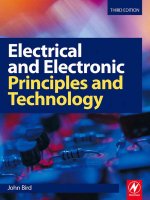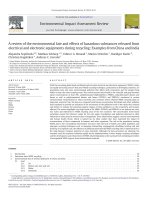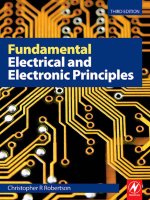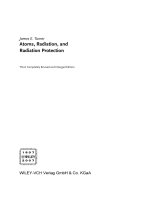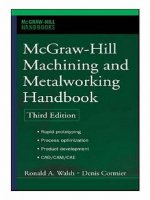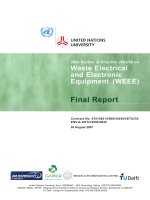Fundamental electrical and electronic principles 3rd ed
Bạn đang xem bản rút gọn của tài liệu. Xem và tải ngay bản đầy đủ của tài liệu tại đây (3.05 MB, 304 trang )
Fundamental Electrical and Electronic Principles
This page intentionally left blank
Fundamental Electrical
and Electronic
Principles
Third Edition
Christopher R Robertson
AMSTERDAM • BOSTON • HEIDELBERG • LONDON • NEW YORK • OXFORD
PARIS • SAN DIEGO • SAN FRANCISCO • SINGAPORE • SYDNEY • TOKYO
Newnes is an imprint of Elsevier
Newnes is an imprint of Elsevier
Linacre House, Jordan Hill, Oxford OX2 8DP, UK
30 Corporate Drive, Suite 400, Burlington, MA 01803, USA
First published 1993 as Electrical and Electronic Principles 1 by Edward Arnold
Second edition 2001
Third edition 2008
Copyright © C. R. Robertson 1993, 2001
Copyright © 2008 Elsevier Ltd. All rights reserved
The right of Christopher R. Robertson to be identifi ed as the author of this work has
been asserted in accordance with the Copyright, Designs and Patents Act 1988
No part of this publication may be reproduced, stored in a retrieval system or
transmitted in any form or by any means electronic, mechanical, photocopying,
recording or otherwise without the prior written permission of the publisher
Permissions may be sought directly from Elsevier ’ s Science & Technology
Rights Department in Oxford, UK: phone ( ϩ 44) (0) 1865 843830; fax ( ϩ 44) (0)
1865 853333; email: . Alternatively you can submit
your request online by visiting the Elsevier web site at />permissions , and selecting Obtaining permission to use Elsevier material
Notice
No responsibility is assumed by the publisher for any injury and/or damage to
persons or property as a matter of products liability, negligence or otherwise, or from
any use or operation of any methods, products, instructions or ideas contained in the
material herein.
British Library Cataloguing in Publication Data
A catalogue record for this book is available from the British Library
Library of Congress Cataloguing in Publication Data
A catalogue record for this book is available from the Library of Congress
ISBN: 978-0-7506-8737-9
Typeset by Charon Tec Ltd., A Macmillan Company.
(www.macmillansolutions.com)
Printed and bound in Slovenia
08 09 10 11 12 10 9 8 7 6 5 4 3 2 1
For information on all Newnes publications visit our
web site at
Preface ix
Introduction xi
1
Fundamentals 1
1.1 Units 1
1.2 Standard Form Notation 2
1.3 ‘ Scienti c ’ Notation 2
1.4 Conversion of Areas and Volumes 4
1.5 Graphs 5
1.6 Basic Electrical Concepts 7
1.7 Communication 26
Summary of Equations 29
Assignment Questions 30
2
D.C. Circuits 31
2.1 Resistors in Series 31
2.2 Resistors in Parallel 35
2.3 Potential Divider 40
2.4 Current Divider 41
2.5 Series/Parallel Combinations 43
2.6 Kirchho ’ s Current Law 48
2.7 Kirchho ’ s Voltage Law 49
2.8 The Wheatstone Bridge Network 55
2.9 The Wheatstone Bridge Instrument 63
2.10 The Slidewire Potentiometer 65
Summary of Equations 68
Assignment Questions 69
Suggested Practical Assignments 72
3
Electric Fields and Capacitors 75
3.1 Coulomb ’ s Law 75
3.2 Electric Fields 76
3.3 Electric Field Strength (E) 78
3.4 Electric Flux () and Flux Density (D) 79
3.5 The Charging Process and Potential Gradient 80
3.6 Capacitance (C) 83
3.7 Capacitors 84
3.8 Permittivity of Free Space (ε
0
) 84
3.9 Relative Permittivity (ε
r
) 84
3.10 Absolute Permittivity (ε) 85
Contents
v
vi
Contents
3.11 Calculating Capacitor Values 85
3.12 Capacitors in Parallel 87
3.13 Capacitors in Series 89
3.14 Series/Parallel Combinations 92
3.15 Multiplate Capacitors 95
3.16 Energy Stored 97
3.17 Dielectric Strength and Working Voltage 101
3.18 Capacitor Types 102
Summary of Equations 105
Assignment Questions 107
Suggested Practical Assignment 110
4
Magnetic Fields and Circuits 111
4.1 Magnetic Materials 111
4.2 Magnetic Fields 111
4.3 The Magnetic Circuit 114
4.4 Magnetic Flux and Flux Density 115
4.5 Magnetomotive Force (mmf ) 116
4.6 Magnetic Field Strength 117
4.7 Permeability of Free Space (
0
) 118
4.8 Relative Permeability (
r
) 119
4.9 Absolute Permeability () 119
4.10 Magnetisation (B/H) Curve 122
4.11 Composite Series Magnetic Circuits 126
4.12 Reluctance (S) 128
4.13 Comparison of Electrical, Magnetic and Electrostatic Quantities 131
4.14 Magnetic Hysteresis 132
4.15 Parallel Magnetic Circuits 134
Summary of Equations 135
Assignment Questions 136
Suggested Practical Assignments 138
5
Electromagnetism 141
5.1 Faraday ’ s Law of Electromagnetic Induction 141
5.2 Lenz ’ s Law 144
5.3 Fleming ’ s Righthand Rule 144
5.4 EMF Induced in a Single Straight Conductor 147
5.5 Force on a Current-Carrying Conductor 151
5.6 The Motor Principle 153
5.7 Force between Parallel Conductors 156
5.8 The Moving Coil Meter 158
5.9 Shunts and Multipliers 162
5.10 Shunts 162
5.11 Multipliers 163
Contents
vii
5.12 Figure of Merit and Loading E ect 166
5.13 The Ohmmeter 170
5.14 Wattmeter 171
5.15 Eddy Currents 172
5.16 Self and Mutual Inductance 174
5.17 Self-Inductance 175
5.18 Self-Inductance and Flux Linkages 176
5.19 Factors A ecting Inductance 179
5.20 Mutual Inductance 180
5.21 Relationship between Self- and Mutual-Inductance 182
5.22 Energy Stored 184
5.23 The Transformer Principle 186
5.24 Transformer Voltage and Current Ratios 188
Summary of Equations 191
Assignment Questions 192
Suggested Practical Assignments 195
6
Alternating Quantities 197
6.1 Production of an Alternating Waveform 197
6.2 Angular Velocity and Frequency 200
6.3 Standard Expression for an Alternating Quantity 200
6.4 Average Value 203
6.5 r.m.s. Value 205
6.6 Peak Factor 206
6.7 Form Factor 207
6.8 Recti ers 208
6.9 Half-wave Recti er 209
6.10 Full-wave Bridge Recti er 210
6.11 Recti er Moving Coil Meter 212
6.12 Phase and Phase Angle 213
6.13 Phasor Representation 216
6.14 Addition of Alternating Quantities 219
6.15 The Cathode Ray Oscilloscope 224
6.16 Operation of the Oscilloscope 226
6.17 Dual Beam Oscilloscopes 228
Summary of Equations 229
Assignment Questions 230
Suggested Practical Assignments 232
7
D.C. Machines 233
7.1 Motor/Generator Duality 233
7.2 The Generation of d.c. Voltage 235
7.3 Construction of d.c. Machines 238
7.4 Classi cation of Generators 238
viii
Contents
7.5 Separately Excited Generator 239
7.6 Shunt Generator 240
7.7 Series Generator 242
7.8 D. C. Motors 244
7.9 Shunt Motor 244
7.10 Series Motor 245
Summary of Equations 247
Assignment Questions 248
8
D.C. Transients 249
8.1 Capacitor-Resistor Series Circuit (Charging) 249
8.2 Capacitor-Resistor Series Circuit (Discharging) 253
8.3 Inductor-Resistor Series Circuit (Connection to Supply) 256
8.4 Inductor-Resistor Series Circuit (Disconnection) 259
Summary of Equations 260
Assignment Questions 261
Suggested Practical Assignments 262
9
Semiconductor Theory and Devices 263
9.1 Atomic Structure 263
9.2 Intrinsic (Pure) Semiconductors 264
9.3 Electron-Hole Pair Generation and Recombination 266
9.4 Conduction in Intrinsic Semiconductors 267
9.5 Extrinsic (Impure) Semiconductors 268
9.6 n-type Semiconductor 268
9.7 p-type Semiconductor 270
9.8 The p-n Junction 271
9.9 The p-n Junction Diode 272
9.10 Forward-biased Diode 273
9.11 Reverse-biased Diode 273
9.12 Diode Characteristics 274
9.13 The Zener Diode 276
Assignment Questions 281
Suggested Practical Assignments 282
Appendix A: SI Units and Quantities 283
Answers to Assignment Questions 285
Index 289
This Textbook supersedes the second edition of Fundamental
Electrical and Electronic Principles. In response to comments
from colleges requesting that the contents more closely match the
objectives of the BTEC unit Electrical and Electronic Principles,
some chapters have been removed and some exchanged with the
companion book Further Electrical and Electronic Principles, ISBN
9780750687478. Also, in order to encourage students to use other
reference sources, those chapters that have been totally removed
may be accessed on the website address evier.
com/companions/9780750687379. The previous edition included
Supplementary Worked Examples at the end of each chapter. The
majority of these have now been included within each chapter as
Worked Examples, and those that have been removed may be accessed
on the above website.
This book continues with the philosophy of the previous editions
in that it may be used as a complete set of course notes for students
undertaking the study of Electrical and Electronic Principles in the
fi rst year of a BTEC National Diploma/Certifi cate course. It also
provides coverage for some other courses, including foundation/
bridging courses which require the study of Electrical and Electronic
Engineering.
Fundamental Electrical and Electronic Principles contains 349
illustrations, 112 worked examples, 26 suggested practical assignments
and 234 assignment questions. The answers to the latter are to be found
towards the end of the book.
The order of the chapters does not necessarily follow the order
set out in any syllabus, but rather follows a logical step-by-step
sequence through the subject matter. Some topic areas may extend
beyond current syllabus requirements, but do so both for the sake of
completeness and to encourage those students wishing to extend their
knowledge.
Coverage of the second year BTEC National Diploma/Certifi cate
unit, Further Electrical Principles, is found in the third edition of the
companion book Further Electrical and Electronic Principles.
C. Robertson
Tonbridge
March 2008
Preface
ix
This page intentionally left blank
The chapters follow a sequence that I consider to be a logical
progression through the subject matter, and in the main, follow
the order of objectives stated in the BTEC unit of Electrical and
Electronic Principles. The major exception to this is that the topics of
instrumentation and measurements do not appear in a specifi c chapter
of that title. Instead, the various instruments and measurement methods
are integrated within those chapters where the relevant theory is
covered.
Occasionally a word or phrase will appear in
bold blue type, and close
by will be a box with a blue background. These emphasised words or
phrases may be ones that are not familiar to students, and within the
box will be an explanation of the words used in the text.
Throughout the book, Worked Examples appear as Q questions
in bold type, followed by A answers. In all chapters, Assignment
Questions are provided for students to solve.
The fi rst chapter deals with the basic concepts of electricity; the use of
standard form and its adaptation to scientifi c notation; SI and derived
units; and the plotting of graphs. This chapter is intended to provide
a means of ensuring that all students on a given course start with the
same background knowledge. Also included in this chapter are notes
regarding communication. In particular, emphasis is placed on logical
and thorough presentation of information, etc. in the solution of
Assignment Questions and Practical Assignment reports.
Introduction
xi
This page intentionally left blank
Fundamentals
Chapter 1
1
1.1 Units
Wherever measurements are performed there is a need for a coherent
and practical system of units. In science and engineering the
International System of units (SI units) form the basis of all units used.
There are seven ‘ base ’ units from which all the other units are derived,
called derived units.
Table 1.1 The SI base units
Quantity Unit Unit symbol
Mass kilogram kg
Length metre m
Time second s
Electric current ampere A
Temperature kelvin K
Luminous intensity candela cd
Amount of substance mole mol
A few examples of derived units are shown in Table 1.2 , and it is worth
noting that different symbols are used to represent the quantity and its
associated unit in each case.
For a more comprehensive list of SI units see Appendix A at the back
of the book.
Table 1.2 Some SI derived units
Quantity
Unit
Name Symbol Name Symbol
Force F Newton N
Power P Watt W
Energy W Joule J
Resistance R Ohm
2
Fundamental Electrical and Electronic Principles
1.2 Standard Form Notation
Standard form is a method of writing large and small numbers in a
form that is more convenient than writing a large number of trailing or
leading zeroes.
For example the speed of light is approximately 300 000 000 m/s.
When written in standard form this fi gure would appears as
3 0 10 10 100 000 000
88
. ϫ m/s, where represents
Similarly, if the wavelength of ‘ red ’ light is approximately
0.000 000 767 m, it is more convenient to write it in standard form as
7 67 10 10 1 10 000 000
77
./ϫϭ
ϪϪ
m, where
It should be noted that whenever a ‘ multiplying ’ factor is required,
the base 10 is raised to a positive power. When a ‘ dividing ’ factor is
required, a negative power is used. This is illustrated below:
10 10 1 10 0 1 10
100 10 1 100 0 01 10
1000 10 1 1000 0
11
22
3
ϭϭϭ
ϭϭϭ
ϭϭ
Ϫ
Ϫ
/.
/.
/.0001 10
3
ϭ
Ϫ
etc. etc.
One restriction that is applied when using standard form is that only
the fi rst non-zero digit must appear before the decimal point.
Thus, 46 500 is written as
465 10 465 10
43
ϫϫ and as not
Similarly, 0.002 69 is written as
2 69 10 26 9 10 269 10
345
ϫϫϫ
ϪϪϪ
and as or not
1.3 ‘ Scienti c ’ Notation
This notation has the advantage of using the base 10 raised to a power
but it is not restricted to the placement of the decimal point. It has the
added advantage that the base 10 raised to certain powers have unique
symbols assigned.
For example if a body has a mass m ϭ 500 000 g.
In standard form this would be written as
m ϭϫ50 10
5
.g.
Using scientifi c notation it would appear as
m ϭ 500 500kg ( kilogram)
Fundamentals
3
where the ‘ k ’ in front of the g for gram represents 10
3
.
Not only is the latter notation much neater but it gives a better ‘ feel ’ to
the meaning and relevance of the quantity.
See Table 1.3 for the symbols (prefi xes) used to represent the various
powers of 10. It should be noted that these prefi xes are arranged in
multiples of 10
3
. It is also a general rule that the positive powers of
10 are represented by capital letters, with the negative powers being
represented by lower case (small) letters. The exception to this rule is
the ‘ k ’ used for kilo.
Worked Example 1.1
Q Write the following quantities in a concise form using (a) standard form, and (b) scienti c notation
(i) 0.000 018 A (ii) 15 000 V (iii) 250 000 000 W
A
(a) (i) 0.000 018 A ϭ 1.8 ϫ 10
Ϫ 5
A
(ii) 15 000 V ϭ 1.5 ϫ 10
4
V
(iii) 250 000 000 W ϭ 2.5 ϫ 10
8
W
(b) (i) 0.000 018 A ϭ 18 A
(ii) 15 000 V ϭ 15 kV
(iii) 250 000 000 W ϭ 250 MW Ans
The above example illustrates the neatness and convenience of the scienti c or
engineering notation.
Worked Example 1.2
Q Write the following quantities in scienti c (engineering) notation. (a) 25 ؋ 10
؊ 5
A, (b) 3 ؋ 10
4
W,
(c) 850 000 J, (d) 0.0016 V .
A
(a) 2 5 ϫ 10
Ϫ 5
ϭ 25 ϫ 10 ϫ 10
Ϫ 6
ϭ 250 ϫ 10
Ϫ 6
and since 10
Ϫ 6
is represented by (micro)
Table 1.3 Unit prefi xes used in ‘scientifi c ’ notation
Multiplying factor Prefi x name Symbol
10
12
tera T
10
9
giga G
10
6
mega M
10
3
kilo k
10
Ϫ 3
milli m
10
Ϫ 6
micro
10
Ϫ 9
nano n
10
Ϫ 12
pico p
4
Fundamental Electrical and Electronic Principles
then 25 ϫ 10
Ϫ 5
A ϭ 250 A Ans
Alternatively, 25 ϫ 10
Ϫ 5
ϭ 25 ϫ 10
Ϫ 2
ϫ 10
Ϫ 3
ϭ 0.25 ϫ 10
Ϫ 3
so 25 ϫ 10
Ϫ 5
A ϭ 0.25 mA Ans
(b) 3 ϫ 10
Ϫ 4
ϭ 3 ϫ 10
Ϫ 1
ϫ 10
Ϫ 3
or 300 ϫ 10
Ϫ 6
so 3 ϫ 10
Ϫ 4
W ϭ 0.3 mW or 300 W Ans
(c) 850 000 ϭ 850 ϫ 10
3
or 0.85 ϫ 10
6
so 850 000 J ϭ 850 kJ or 0.85 MJ Ans
(d) 0.0016 ϭ 1.6 ϫ 10
Ϫ 3
so 0.0016 V ϭ 1.6 mV Ans
1.4 Conversion of Areas and Volumes
Consider a square having sides of 1 m as shown in Fig. 1.1 . In this case
each side can also be said to be 100 cm or 1000 mm. Hence the area A
enclosed could be stated as:
A
A
A
ϭϫϭ
ϭϫϭϫϭ
ϭϫϭϫ
11 1
100 100 10 10 10
1000 1000 10 10
2
22 42
33
m
or cm
or ϭϭ 10
6
mm .
2
1m
1m
Fig. 1.1
From the above it may be seen that
110
110
242
26
mcm
and that m mm .
2
ϭ
ϭ
Similarly, if the square had sides of 1 cm the area would be
A ϭ ϭϫϭ
ϪϪ Ϫ
1101010
22242
cm m .
Again if the sides were of length 1 mm the area would be
A ϭ ϭϫϭ
ϪϪ Ϫ
1101010
23362
mm m .
Thus 1 c m
2
ϭ 10
Ϫ
4
m
2
and 1 mm
2
ϭ 10
Ϫ
6
m
2
.
Fundamentals
5
Since the basic unit for area is m
2
, then areas quoted in other units
should fi rstly be converted into square metres before calculations
proceed. This procedure applies to all the derived units, and it is
good practice to convert all quantities into their ‘ basic ’ units before
proceeding with calculations.
It is left to the reader to confi rm that the following conversions for
volumes are correct:
110
110
39
363
mm m
cm m .
3
ϭ
ϭ
Ϫ
Ϫ
Worked Example 1.3
Q A mass m of 750 g is acted upon by a force F of 2 N. Calculate the resulting acceleration given that the
three quantities are related by the equation
F ؍ ma newton
A
m ϭ 750 g ϭ 0.75 kg; F ϭ 2 N
Since newton, then
metre/second
so m/
Fma
a
F
m
a
ϭ
ϭ
ϭ
ϭ
2
2
075
2 667
.
.ss
2
Ans
1.5 Graphs
A graph is simply a pictorial representation of how one quantity or
variable relates to another. One of these is known as the dependent
variable and the other as the independent variable. It is general
practice to plot the dependent variable along the vertical axis and
the independent variable along the horizontal axis of the graph. To
illustrate the difference between these two types of variable consider
the case of a vehicle that is travelling between two points. If a graph
of the distance travelled versus the time elapsed is plotted, then the
distance travelled would be the dependent variable. This is because the
distance travelled depends on the time that has elapsed. But the time
is independent of the distance travelled, since the time will continue to
increase regardless of whether the vehicle is moving or not.
Such a graph is shown in Fig. 1.2 , from which it can be seen that over
the fi rst three hours the distance travelled was 30 km. Over the next
two hours a further 10 km was travelled, and subsequently no further
distance was travelled. Since distance travelled divided by the time
6
Fundamental Electrical and Electronic Principles
taken is velocity, then the graph may be used to determine the speed of
the vehicle at any time. Another point to note about this graph is that
it consists of straight lines. This tells us that the vehicle was travelling
at different but constant velocities at different times. It should be
apparent that the steepest part of the graph occurs when the vehicle was
travelling fastest. To be more precise, we refer to the slope or gradient
of the graph. In order to calculate the velocity over the fi rst three hours,
the slope can be determined as follows:
Change in time, t
1
ϭ 3 Ϫ 0 ϭ 3 h
change in distance s
1
ϭ 30 Ϫ 0 ϭ 3 0 k m
slope or gradient
velocity km/hv
s
t
ϭϭϭ
1
1
30
3
10
Similarly, for the second section of the graph:
v
s
t
ϭϭ
Ϫ
Ϫ
ϭ
2
2
40 30
53
5
()
()
km/h
Considering the fi nal section of the graph, it can be seen that there is no
change in distance (the vehicle is stationary). This is confi rmed, since
if s is zero then the velocity must be zero.
In some ways this last example is a special case, since it involved a
straight line graph. In this case we can say that the distance is directly
proportional to time. In many cases a non-linear graph is produced, but
the technique for determining the slope at any given point is similar.
Such a graph is shown in Fig. 1.3 , which represents the displacement
of a mass when subjected to simple harmonic motion. The resulting
graph is a sinewave. To determine the slope at any given instant in time
we would have to determine the slope of the tangent to the curve at
that point on the graph. If this is done then the fi gure obtained in each
case would be the velocity of the mass at that instant. Notice that the
slope is steepest at the instants that the curve passes through the zero
displacement axis (maximum velocity). It is zero at the ‘ peaks ’ of the
graph (zero velocity). Also note that if the graph is sloping upwards
s (km)
40
30
20
10
0
12345
t (h)
δ t
1
δ s
1
δ t
2
δ s
2
Fig. 1.2
Fundamentals
7
as you trace its path from left to right it is called a positive slope. If it
slopes downwards it is called a negative slope.
1.6 Basic Electrical Concepts
All matter is made up of atoms, and there are a number of ‘ models ’
used to explain physical effects that have been both predicted and
subsequently observed. One of the oldest and simplest of these is the
Bohr model. This describes the atom as consisting of a central nucleus
containing minute particles called protons and neutrons. Surrounding
the nucleus are a number of electrons in various orbits. This model is
illustrated in Fig. 1.4 . The possible presence of neutrons in the nucleus
has been ignored, since these particles play no part in the electrical
concepts to be described. It should be noted that this atomic model is
greatly over-simplifi ed. It is this very simplicity that makes it ideal for
the beginner to achieve an understanding of what electricity is and how
many electrical devices operate.
The model shown in Fig. 1.4 is not drawn to scale since a proton is
approximately 2000 times more massive than an electron. Due to
this relatively large mass the proton does not play an active part in
electrical current fl ow. It is the behaviour of the electrons that is more
important. However, protons and electrons do share one thing in
zero slope
t (s)
negative
slope
positive
slope
ϩ
Ϫ
S (mm)
0
Fig. 1.3
Ϫ
ϩ
ϩ
ϩ
ϩ
ϩ
Ϫ
Ϫ
Ϫ
Ϫ
Ϫ
Fig. 1.4
8
Fundamental Electrical and Electronic Principles
common; they both possess a property known as electric charge. The
unit of charge is called the coulomb (C). Since charge is considered
as the quantity of electricity it is given the symbol Q. An electron and
proton have exactly the same amount of charge. The electron has a
negative charge, whereas the proton has a positive charge. Any atom
in its ‘ normal ’ state is electrically neutral (has no net charge). So, in
this state the atom must possess as many orbiting electrons as there
are protons in its nucleus. If one or more of the orbiting electrons
can somehow be persuaded to leave the parent atom then this charge
balance is upset. In this case the atom acquires a net positive charge,
and is then known as a positive ion. On the other hand, if ‘ extra ’
electrons can be made to orbit the nucleus then the atom acquires a net
negative charge. It then becomes a negative ion.
An analogy is a technique where the behaviour of one system is compared to the
behaviour of another system. The system chosen for this comparison will be one that is
more familiar and so more easily understood. HOWEVER, it must be borne in mind that an
analogy should not be extended too far. Since the two systems are usually very different
physically there will come a point where comparisons are no longer valid
You may now be wondering why the electrons remain in orbit around
the nucleus anyway. This can best be explained by considering an
analogy . Thus, an electron orbiting the nucleus may be compared
to a satellite orbiting the Earth. The satellite remains in orbit due to
a balance of forces. The gravitational force of attraction towards the
Earth is balanced by the centrifugal force on the satellite due to its high
velocity. This high velocity means that the satellite has high kinetic
energy. If the satellite is required to move into a higher orbit, then its
motor must be fi red to speed it up. This will increase its energy. Indeed,
if its velocity is increased suffi ciently, it can be made to leave Earth
orbit and travel out into space. In the case of the electron there is also
a balance of forces involved. Since both electrons and protons have
mass, there will be a gravitational force of attraction between them.
However the masses involved are so minute that the gravitational force
is negligible. So, what force of attraction does apply here? Remember
that electrons and protons are oppositely charged particles, and
oppositely charged bodies experience a force of attraction. Compare
this to two simple magnets, whereby opposite polarities attract and like
(the same) polarities repel each other. The same rule applies to charged
bodies. Thus it is the balance between this force of electrostatic
attraction and the kinetic energy of the electron that maintains the orbit.
It may now occur to you to wonder why the nucleus remains intact,
since the protons within it are all positively charged particles! It is
beyond the scope of this book (and of the course of study on which you
are now embarked) to give a comprehensive answer. Suffi ce to say that
there is a force within the nucleus far stronger than the electrostatic
repulsion between the protons that binds the nucleus together.
Fundamentals
9
All materials may be classifi ed into one of three major groups—
conductors, insulators and semiconductors. In simple terms, the group
into which a material falls depends on how many ‘ free ’ electrons it has.
The term ‘ free ’ refers to those electrons that have acquired suffi cient
energy to leave their orbits around their parent atoms. In general we
can say that conductors have many free electrons which will be drifting
in a random manner within the material. Insulators have very few free
electrons (ideally none), and semiconductors fall somewhere between
these two extremes.
Electric current This is the rate at which free electrons can be made
to drift through a material in a particular direction. In other words, it
is the rate at which charge is moved around a circuit. Since charge is
measured in coulombs and time in seconds then logically the unit for
electric current would be the coulomb/second. In fact, the amount of
current fl owing through a circuit may be calculated by dividing the
amount of charge passing a given point by the time taken. The unit
however is given a special name, the ampere (often abbreviated to
amp). This is fairly common practice with SI units, whereby the names
chosen are those of famous scientists whose pioneering work is thus
commemorated. The relationship between current, charge and time can
be expressed as a mathematical equation as follows:
I
Q
t
QItϭϭ amp, or coulomb
(1.1)
Worked Example 1.4
Q A charge of 35 mC is transferred between two points in a circuit in a time of 20 ms. Calculate the value
of current owing.
A
Q ϭ 35 ϫ 10
Ϫ 3
C; t ϭ 20 ϫ 10
Ϫ 3
s
I
I
ϭ
ϭ
ϫ
ϫ
ϭ
Ϫ
Ϫ
Q
t
amp
A
35 0
20 0
75
3
3
1
1
1. Ans
Worked Example 1.5
Q If a current of 12 0 μ A ows for a time of 15 s, determine the amount of charge transferred.
A
I ϭ 120 ϫ 10
Ϫ 6
A; t ϭ 15 s
Qt
Q
ϭ
ϭϫ ϫ
ϭ
Ϫ
I coulomb
mC
11 1
1
20 0 5
8
6
. Ans
10
Fundamental Electrical and Electronic Principles
Worked Example 1.6
Q 80 coulombs of charge was transferred by a current of 0.5 A. Calculate the time for which the current
owed.
A
Q ϭ 80 C; I ϭ 0.5 A
t
Q
t
ϭ
ϭ
ϭ
I
seconds
s
80
05
60
.
1 Ans
Electromotive Force (emf) The random movement of electrons within
a material does not constitute an electrical current. This is because it
does not result in a drift in one particular direction. In order to cause the
‘ free ’ electrons to drift in a given direction an electromotive force must
be applied. Thus the emf is the ‘ driving ’ force in an electrical circuit.
The symbol for emf is E and the unit of measurement is the volt (V).
Typical sources of emf are cells, batteries and generators.
The amount of current that will fl ow through a circuit is directly
proportional to the size of the emf applied to it. The circuit diagram
symbols for a cell and a battery are shown in Figs. 1.5(a) and (b)
respectively. Note that the positively charged plate (the long line)
usually does not have a plus sign written alongside it. Neither does
the negative plate normally have a minus sign written by it. These
signs have been included here merely to indicate (for the fi rst time) the
symbol used for each plate.
Fig. 1.5
ϩϪ
(a)
ϩϩϪ
(b)
Resistance (R) Although the amount of electrical current that will
fl ow through a circuit is directly proportional to the applied emf, the
other property of the circuit (or material) that determines the resulting
current is the opposition offered to the fl ow. This opposition is known
as the electrical resistance, which is measured in ohms ( ). Thus
conductors, which have many ‘ free ’ electrons available for current
carrying, have a low value of resistance. On the other hand, since
insulators have very few ‘ free ’ charge carriers then insulators have a
very high resistance. Pure semiconductors tend to behave more like
insulators in this respect. However, in practice, semiconductors tend
to be used in an impure form, where the added impurities improve
the conductivity of the material. An electrical device that is designed
to have a specifi ed value of resistance is called a resistor. The circuit
diagram symbol for a resistor is shown in Fig. 1.6 .
Fundamentals
11
Potential Difference (p.d.) Whenever current fl ows through a resistor
there will be a p.d. developed across it. The p.d. is measured in volts,
and is quite literally the difference in voltage levels between two points
in a circuit. Although both p.d. and emf are measured in volts they are
not the same quantity. Essentially, emf (being the driving force) causes
current to fl ow; whilst a p.d. is the result of current fl owing through a
resistor. Thus emf is a cause and p.d. is an effect. It is a general rule
that the symbol for a quantity is different to the symbol used for the
unit in which it is measured. One of the few exceptions to this rule
is that the quantity symbol for p.d. happens to be the same as its unit
symbol, namely V. In order to explain the difference between emf and
p.d. we shall consider another analogy.
Figure 1.7 represents a simple hydraulic system consisting of a
pump, the connecting pipework and two restrictors in the pipe.
The latter will have the effect of limiting the rate at which the water
fl ows around the circuit. Also included is a tap that can be used to
interrupt the fl ow completely. Figure 1.8 shows the equivalent
electrical circuit, comprising a battery, the connecting conductors
(cables or leads) and two resistors. The latter will limit the
amount of current fl ow. Also included is a switch that can be
used to ‘ break ’ the circuit and so prevent any current fl ow. As far
as each of the two systems is concerned we are going to make some
assumptions.
For the water system we will assume that the connecting pipework has
no slowing down effect on the fl ow, and so will not cause any pressure
water
flow
restrictors
tap
p
1
p
2
P
pump
Fig. 1.7
Fig. 1.6
12
Fundamental Electrical and Electronic Principles
drop. Provided that the pipework is relatively short then this is a
reasonable assumption. The similar assumption in the electrical circuit
is that the connecting wires have such a low resistance that they will
cause no p.d. If anything, this is probably a more legitimate assumption
to make. Considering the water system, the pump will provide the total
system pressure (P) that circulates the water through it. Using some
form of pressure measuring device it would be possible to measure this
pressure together with the pressure drops (p
l
and p
2
) that would occur
across the two restrictors. Having noted these pressure readings it
would be found that the total system pressure is equal to the sum of the
two pressure drops. Using a similar technique for the electrical circuit,
it would be found that the sum of the two p.d.s ( V
1
and V
2
) is equal to
the total applied emf E volts. These relationships may be expressed in
mathematical form as:
P p p pascalϭϩ
12
and
EVVϭϩ
12
volt (1.2)
When the potential at some point in a circuit is quoted as having a
particular value (say 10 V) then this implies that it is 10 V a b o v e
some reference level or datum. Compare this with altitudes. If a
mountain is said to be 5000 m high it does not necessarily mean
that it rises 5000 m from its base to its peak. The fi gure of 5000 m
refers to the height of its peak above mean sea level. Thus, mean
sea level is the reference point or datum from which altitudes are
measured. In the case of electrical potentials the datum is taken to
be the potential of the Earth which is 0 V. Similarly, Ϫ 10 V means
10 V below or less than 0 V.
Conventional current and electron fl ow You will notice in Fig. 1.8
that the arrows used to show the direction of current fl ow indicate that
this is from the positive plate of the battery, through the circuit, returning
to the negative battery plate. This is called conventional current fl ow.
However, since electrons are negatively charged particles, then these
must be moving in the opposite direction. The latter is called electron
R
1
V
1
V
2
R
2
E
I
SW
Fig. 1.8


